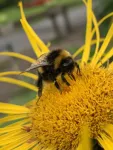(Press-News.org) With the first paper compiling all known information about planets like Venus beyond our solar system, scientists are the closest they’ve ever been to finding an analog of Earth’s “twin.”
If they succeed in locating one, it could reveal valuable insights into Earth’s future, and our risk of developing a runaway greenhouse climate as Venus did.
Scientists who wrote the paper began with more than 300 known terrestrial planets orbiting other stars, called exoplanets. They whittled the list down to the five most likely to resemble Venus in terms of their radii, masses, densities, the shapes of their orbits, and perhaps most significantly, distances from their stars.
The paper, published in The Astronomical Journal, also ranked the most Venus-like planets in terms of the brightness of the stars they orbit, which increases the likelihood that the James Webb Space Telescope would get more informative signals regarding the composition of their atmospheres.
Today’s Venus floats in a nest of sulfuric acid clouds, has no water, and features surface temperatures of up to 900 degrees Fahrenheit — hot enough to melt lead. Using the Webb telescope to observe these possible Venus analogs, or “exoVenuses,” scientists hope to learn if things were ever different for our Venus.
“One thing we wonder is if Venus could once have been habitable,” said Colby Ostberg, lead study author and UC Riverside Ph.D. student. ‘To confirm this, we want to look at the coolest of the planets in the outer edge of the Venus zone, where they get less energy from their stars.”
The Venus Zone is a concept proposed by UCR astrophysicist Stephen Kane in 2014. It is similar to the concept of a habitable zone, which is a region around a star where liquid surface water could exist.
“The Venus Zone is where it would be too hot to have water, but not hot enough that the planet’s atmosphere gets stripped away,” Ostberg explained. “We want to find planets that still have significant atmospheres.”
Finding a planet similar to Venus in terms of planet mass is also important because mass affects how long a planet is able to maintain an active interior, with the movement of rocky plates across its outer shell known as plate tectonics.
“Venus has 20% less mass than Earth, and as a result, scientists believe there may not be any tectonic activity there. Therefore, Venus has a hard time taking carbon out of its atmosphere,” Ostberg explained. “The planet just can’t get rid of it.”
Another aspect of an active planet interior is volcanic activity, and evidence uncovered just this month suggests Venus still has active volcanoes. “The large number of Venus analogs identified in our paper will allow us to test if such volcanic activity is the norm amongst similar planets, or not,” said Kane, who co-authored the study.
The research team is proposing the planets identified in the paper as targets for the Webb telescope in 2024. Webb is the most expensive and advanced observation tool ever created and will enable scientists not only to see whether the exoVenuses have atmospheres, but also what they’re made of.
The Webb observations may reveal biosignature gases in the atmosphere of an exoVenus, such as methane, methyl bromide or nitrous oxide, which could signal the presence of life.
“Detecting those molecules on an exoVenus would show that habitable worlds can exist in the Venus Zone and strengthen the possibility of a temperate period in Venus’ past,” Ostberg said.
These observations will be complemented by NASA’s two upcoming missions to Venus, in which Kane will play an active role. The DAVINCI mission will also measure gases in the Venusian atmosphere, while the VERITAS mission will enable 3D reconstructions of the landscape.
All of these observations are leading toward the ultimate question that Kane poses in much of his work, which attempts to understand the Earth-Venus divergence in climate: “Is Earth weird or is Venus the weird one?”
“It could be that one or the other evolved in an unusual way, but it’s hard to answer that when we only have two planets to analyze in our solar system, Venus and Earth. The exoplanet explorations will give us the statistical power to explain the differences we see,” Kane said.
If the planets on the new list turn out to indeed be much like Venus, that would show the outcome of Venus’ evolution is common.
“That would be a warning for us here on Earth because the danger is real. We need to understand what happened there to make sure it doesn’t happen here,” Kane said.
END
Hunting Venus 2.0: Scientists sharpen their sights
Study narrows James Webb Space Telescope targets
2023-03-22
ELSE PRESS RELEASES FROM THIS DATE:
New research reveals a potential mechanism for how coffee may reduce the risk of type 2 diabetes
2023-03-22
New scientific research investigates inflammation and insulin resistance in habitual coffee drinkers to understand how coffee may reduce the risk of type 2 diabetes (T2D), mediated by inflammatory biomarkers in the body 1.
Drinking just one additional cup of coffee per day was associated with a 4-6% lower risk of T2D among participants in two large prospective cohort studies, which was partly explained by lower levels of inflammation1.
Experts consider consuming up to 400mg of caffeine (3-5 cups of coffee) per day to be a moderate and safe amount for most adults. For pregnant or lactating women, caffeine intake should be reduced to 200mg per day2.
These results further support previous ...
Big firms are failing to reduce unconscious bias against disabled people
2023-03-22
Working for a big company or in an HR role does not lower the likelihood of showing unconscious bias against disabled people at work, a new study finds.
Researchers say this is ‘surprising’ because of the money many large firms spend on EDI and unconscious bias training – in 2017 up to $8bn in the US alone – and the fact HR professionals are often specifically trained in EDI issues.
The research, a collaboration between the University of Exeter’s Business School and Medical ...
Does birth by cesarean section affect children’s academic performance and intelligence?
2023-03-22
In a study of Danish children born between 1978–2000, chances of graduating from lower and upper secondary education were significantly lower for children born by cesarean section (CS). However, differences in grade point averages and intelligence scores were very small. The study, which is published in Acta Obstetricia et Gynecologica Scandinavica, also found that males born by CS had a lower likelihood of appearing before a conscription board for drafting into the military.
In Denmark, most students are 6–16 years old while in lower secondary education (LSE) and 16–17 years old when initiating ...
Can moderate dietary salt restriction help patients with hypertension?
2023-03-22
Results from a clinical trial published in the Journal of Internal Medicine reveal several health benefits of moderate salt restriction in patients on standard medical treatment for primary aldosteronism.
Primary aldosteronism—a condition in which the adrenal glands make too much of the hormone aldosterone—is a common cause of secondary hypertension. The combination of aldosterone excess and high dietary salt intake leaves affected patients with a higher risk of cardiovascular disease than patients with hypertension ...
How fisheries threaten seals and sea lions in South America
2023-03-22
Seals, sea lions, and fur seals are at risk from interactions with fisheries and aquaculture, as they can become entangled in nets or cages, and drown. In a study published in Mammal Review, investigators analyzed research from the last 25 years on operational and biological interactions between these marine mammals and fisheries and aquaculture activities in South American waters.
The authors found that two species are primarily involved in interactions in many countries: the South American sea lion Otaria flavescens and the South American fur seal Arctocephalus australis. ...
Does care during pregnancy differ based on patient race in the United States?
2023-03-22
In an analysis of perinatal care provided in the United States, investigators found few differences by race for care that was based on guidelines or expert recommendations; however, discretionary care (for which professional recommendations or guidelines do not exist) varied by race.
The analysis, which is published in Birth, included information from the electronic health records for 7,056 women who delivered infants within a large hospital system between 2012 and 2018. Compared with Non-Hispanic white women, Non-Hispanic Black women were ...
Are there sex-based differences in brain development during early childhood?
2023-03-22
New research published in Human Brain Mapping reveals sex differences and developmental changes in the brain’s white matter—which provides communication between different parts of the brain—in healthy, typically developing infants and 5-year-olds.
The results, which highlighted sexual dimorphism in brain structure during development with significant detectable differences in multiple regions at the age of 5 years, agree with prior studies showing earlier brain development in females.
Also, changes in white matter asymmetry patterns occurred during early childhood, and in 5-year-olds the pattern already resembled adult-like patterns.
“We observed sex differences ...
Boosting the effects of a particular microRNA may benefit patients with cervical cancer
2023-03-22
Dysregulation of microRNAs, which are molecules involved in controlling gene expression, can promote tumor formation and progression. A study in The FASEB Journal found that the miR-145 microRNA can suppress the growth of cervical cancer cells.
miR-145 was expressed at lower than normal levels in human cervical cancer cells, and lower levels correlated with more advanced clinical stages of cervical cancer in patients.
Experiments in cells and mice revealed the mechanisms behind miR-145 effects and pointed to potential targets that could be ...
Changing temperatures increase pesticide risk to bees
2023-03-22
Temperature influences how badly pesticides affect bees’ behaviour, suggesting uncertain impacts under climate change, according to a new study.
The findings indicate that future extreme temperature events under climate change could increase the impact of pesticides on bee populations and their pollination services.
Certain pesticides, particularly a class called neonicotinoids, are known to impact bees and other important insects, and are thought to be contributing to population declines. However, bees’ reported responses to this threat across the world often seem to vary, suggesting other interacting factors ...
Research reveals substantial human cost of international COVID-19 travel and border restrictions
2023-03-22
Findings paint a bleak picture of little or no financial and health support from governments for their citizens stuck overseas.
At least two-thirds of those stranded aboard experienced financial distress and moderate-to-severe levels of depression—a rate that is substantially higher than the general population and health care professionals in the pandemic.
**Note: the release below is a special early release from the European Congress of Clinical Microbiology & Infectious Diseases (ECCMID 2023, Copenhagen, 15-18 April). Please credit the congress if you use this story**
**Note – the press release is available in Spanish and ...
LAST 30 PRESS RELEASES:
When scientists build nanoscale architecture to solve textile and pharmaceutical industry challenges
Massive cloud with metallic winds discovered orbiting mystery object
Old diseases return as settlement pushes into the Amazon rainforest
Takeaways are used to reward and console – study
Velocity gradients key to explaining large-scale magnetic field structure
Bird retinas function without oxygen – solving a centuries-old biological mystery
Pregnancy- and abortion-related mortality in the US, 2018-2021
Global burden of violence against transgender and gender-diverse adults
Generative AI use and depressive symptoms among US adults
Antibiotic therapy for uncomplicated acute appendicitis
Childhood ADHD linked to midlife physical health problems
Patients struggle to measure blood pressure at home
A new method to unlock vast lithium stores
Scientists unveil “dissolution barocaloric” cooling, opening new path to zero-carbon refrigeration
Microplastics in the atmosphere: Higher emissions from land areas than from the ocean
Metal clumps in quantum state: Vienna research team breaks records
PolyU develops new human-safe magnetorheological fibres, leading innovations in smart wearable textiles
Rice establishes Global Brain Economy Initiative in Davos, aligned with new report on brain health and AI
Quantum error correction with logical qubits
Nutrient-stimulated hormone-based therapies: A new frontier in the prevention and management of MASH-associated hepatocellular carcinoma
Trauma or toxic? A deep dive into the impact of stress on kids' health
Turning industrial exhaust into useful materials with a new electrode
ORNL to partner with Type One Energy, UT on world-class facility to validate next-gen fusion
New journal section tackles AI, ethics, and digital health communication
Jeonbuk National University researchers develop novel dual-chemical looping method for efficient ammonia synthesis
New study sheds light on stroke recovery via exercise-induced migration of mitochondria
SEOULTECH researchers develop sodium-based next-generation smart electrochromic windows
Data-driven analysis reveals three archetypes of armed conflicts
Heart disease, stroke deaths down, yet still kill more in US than any other cause
Light switches made of ultra-thin semiconductor layers
[Press-News.org] Hunting Venus 2.0: Scientists sharpen their sightsStudy narrows James Webb Space Telescope targets



